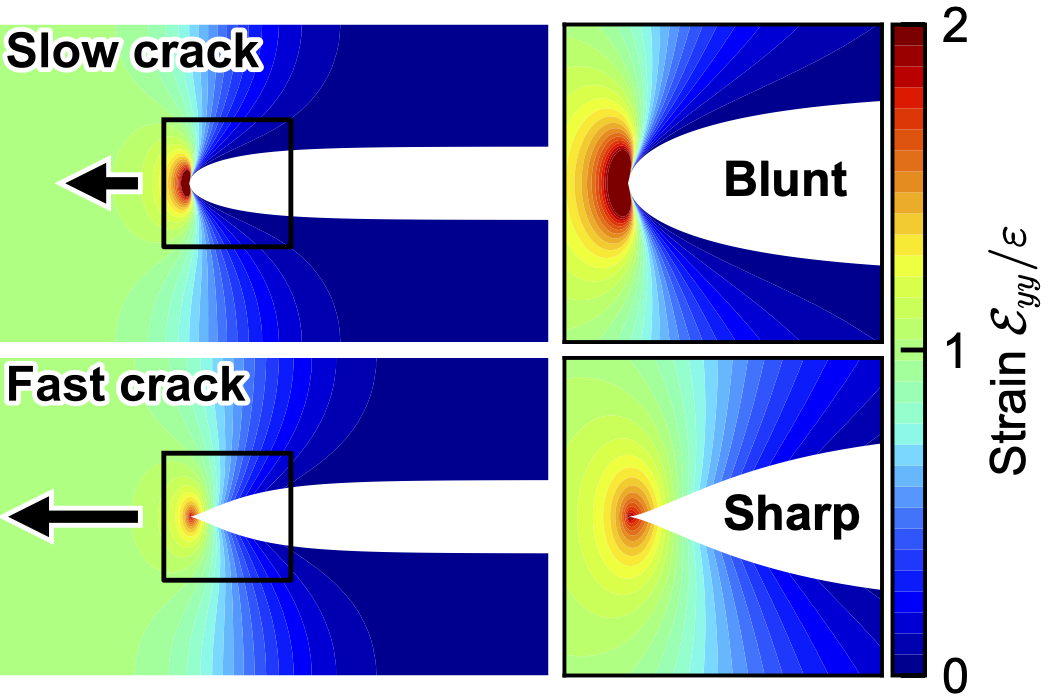Summary
A research group comprising Ph.D. student Hokuto Nagatakiya, Assistant Professor Shunsuke Kobayashi, and Professor Ryuichi Tarumi from the University of Osaka, together with Associate Professor Naoyuki Sakumichi from ZEN University (also Project Associate Professor at the University of Tokyo), has mathematically elucidated for the first time why a crack tip becomes sharp during high-speed fracture in rubber—a phenomenon that had remained unexplained for decades.
When rubber balloons pop or tires burst, small cracks propagate instantaneously. The research team mathematically solved this crack propagation problem, deriving equations that describe both crack shape and overall material deformation. Their analysis proves that crack tip sharpening arises solely from viscoelasticity—the fundamental property of rubberlike materials where mechanical response depends on deformation rate. When stretched slowly, these materials behave like soft rubber; when stretched rapidly, they exhibit viscous behavior and dissipate energy; and when stretched at even higher rates, they become glass-like and rigid. During high-speed crack propagation, the crack tip region becomes glassy, the intermediate zone exhibits viscous behavior, and the far-field region remains rubbery. As crack velocity increases, the viscous zone expands, causing the crack tip to sharpen.
Remarkably, the derived mathematical expression reproduces the crack shape of the "viscoelastic trumpet theory" proposed nearly 30 years ago by Nobel Physics laureate Pierre-Gilles de Gennes, who predicted trumpet-shaped crack profiles using scaling arguments. While de Gennes' original derivation lacked a clear connection to conventional fracture mechanics, this work provides the first rigorous derivation from continuum mechanics fundamentals, offering decisive mathematical validation of his long-standing theory. The study also reveals the strain distribution throughout the material, explaining recently observed experimental phenomena such as strain plateaus ahead of propagating cracks.
This breakthrough provides the theoretical foundation for controlling fracture in viscoelastic materials ranging from automotive tires to medical devices. The findings enable physics-based material design rather than trial-and-error approaches, with potential applications in enhancing durability, improving safety, and reducing environmental impact through extended product lifespans. The findings were published online as a Letter in Physical Review Research on October 1st, 2025 (US Eastern Time).
Papers
Journal: Physical Review Research
Title: Analytical expression for fracture profile in viscoelastic crack propagation
Authors: Hokuto Nagatakiya, Naoyuki Sakumichi, Shunsuke Kobayashi, and Ryuichi Tarumi
DOI: 10.1103/4gnw-ys42

Figure Caption: Changes in crack tip shape and strain distribution with crack propagation velocity. (Top) At slow crack velocities, the crack tip exhibits a blunt parabolic shape. (Bottom) At high crack velocities, viscoelastic effects cause the crack tip to become sharp. The degree of crack tip sharpening is determined by the product of the material's viscoelastic relaxation time and the crack propagation velocity.
